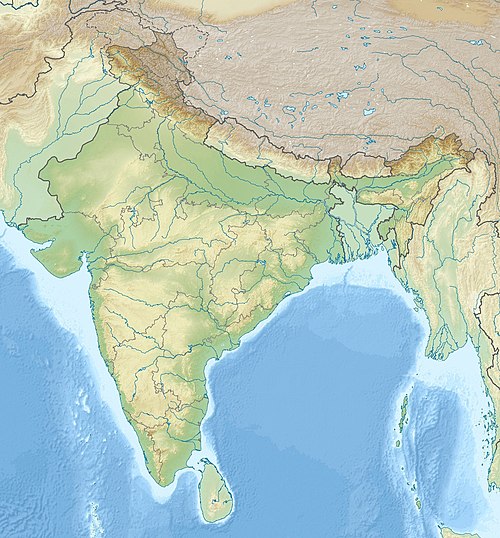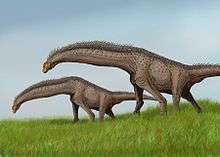Lameta Formation
The Lameta Formation, also known as the Intertrappean Beds is a sedimentary rock formation found in Madhya Pradesh, Gujarat, and Maharashtra, India. It is of Maastrichtian age (Late Cretaceous), and is notable for its dinosaur fossils. Many dubious names have been created for isolated bones, but several genera of dinosaurs from these rocks are well-supported, including the titanosaur sauropod Isisaurus and the abelisaurs Indosaurus, Indosuchus, Laevisuchus, and Rajasaurus.[1] As well as mammals, snakes and other fossils.
| Lameta Formation Stratigraphic range: Maastrichtian ~66 Ma | |
|---|---|
| Type | Geological formation |
| Underlies | Deccan Traps deposits |
| Overlies | Precambrian Basement |
| Area | 5,000 km2 (1,900 sq mi) |
| Thickness | Variable, typically 18–45 m (59–148 ft) |
| Lithology | |
| Primary | Claystone, sandstone limestone |
| Other | Conglomerate |
| Location | |
| Coordinates | 23.2°N 80.0°E |
| Approximate paleocoordinates | 24.7°S 63.2°E |
| Region | Western India |
| Country | |
| Extent | Madhya Pradesh, Gujarat, Maharashtra |
 Lameta Formation (India) | |
Dinosaurs
| Genus | Species | Location | Stratigraphic position | Material | Notes | Images |
|---|---|---|---|---|---|---|
| Indosaurus | I. matleyi | Partial skeleton, including a partial skull.[2] | ||||
| Brachypodosaurus | B. gravis | "Humerus."[3] | ||||
| Coeluroides | C. largus | "Isolated vertebrae."[4] | ||||
| Dryptosauroides | D. grandis | "Vertebrae."[4] | ||||
| Indosuchus | I. raptorius | Cranial remains, including two braincases, as well as a nearly complete skeleton.[2] |  | |||
| Isisaurus | I. colberti |  | ||||
| Jainosaurus | J. septentrionalis | "Basicranium and partial postcranial skeleton."[5] | ||||
| Jubbulpuria | J. tenuis | "Vertebrae."[4] | ||||
| Lametasaurus | L. indicus | "Sacrum, ilia, tibia."[4] "Sacrum, ilia, tibia, spines, armor."[6] | ||||
| Laevisuchus | L. indicus | Only vertebrae.[2] | ||||
| Ornithomimoides | O. barasimlensis | "Vertebrae."[4] | ||||
| O. mobilis | "Vertebrae"[4] | |||||
| Orthogoniosaurus | O. matleyi | "Tooth"[4] | ||||
| Rahiolisaurus | R. gujaratensis |  | ||||
| Rajasaurus | R. narmadensis |  | ||||
| Titanosaurus | T. blanfordi | "Caudal vertebrae."[7] | ||||
| T. rahioliensis | "Teeth"[8] | |||||
Snakes
| Genus | Species | Location | Stratigraphic position | Material | Notes | Images |
|---|---|---|---|---|---|---|
| Sanajeh | S. indicus | A skull, precloaca vertebrae and ribs. | A madtsoiid snake |  Sanajeh about to attack a titanosaur hatchling | ||
| Indophis | I. sahnii | Naskal microvertebrate site | Vertebrae | |||
Mammals
| Genus | Species | Location | Stratigraphic position | Material | Notes | Images |
|---|---|---|---|---|---|---|
| Bharattherium | B. bonapartei | Kisalpuri | ||||
| Deccanolestes | D. hislopi | Naskal microvertebrate site | Molars, calcanea, astralgi, humerus, ulna | |||
| D. robustus | Naskal microvertebrate site | "Dental material and an astragalus" | ||||
| D. narmadensis | Kisalpuri | |||||
| Kharmerungulatum | K. vanvaleni | Kisalpuri | ||||
| Dakshina | D. jederi | Naskal microvertebrate site | Teeth | Sudamericid | ||
| Sahnitherium | S. rangapurensis | Rangapur microvertebrate site | Upper Molar | |||
Turtles
| Genus | Species | Location | Stratigraphic position | Material | Notes | Images |
|---|---|---|---|---|---|---|
| Jainemys | J. pisdurensis | A bothremydid soft shelled turtle | ||||
gollark: I must have factorised this incorrectly. Troubling.
gollark: Hmm, yes, you are right.
gollark: Hold on, my calculator can do this too probably.
gollark: -3, 1? I got that it isn't between 1 and 2. Troubling.
gollark: Question 10 out of 12.
See also
- List of dinosaur-bearing rock formations
- Geology of India
- Deccan Traps
- Maevarano Formation, contemporaneous fossiliferous formation of Madagascar
References
- Weishampel et al., 2004, pp.517-606
- "Table 3.1," in Weishampel, et al. (2004). Page 49.
- "Table 17.1," in Weishampel, et al. (2004). Page 367.
- "Table 3.1," in Weishampel, et al. (2004). Page 50.
- "Table 13.1," in Weishampel, et al. (2004). Page 269.
- "Table 17.1," in Weishampel, et al. (2004). Page 368.
- "Table 13.1," in Weishampel, et al. (2004). Page 270.
- "Table 13.1," in Weishampel, et al. (2004). Page 271.
Bibliography
- Weishampel, David B.; Peter Dodson, and Halszka Osmólska (eds.). 2004. The Dinosauria, 2nd edition, 1–880. Berkeley: University of California Press. Accessed 2019-02-21. ISBN 0-520-24209-2
This article is issued from Wikipedia. The text is licensed under Creative Commons - Attribution - Sharealike. Additional terms may apply for the media files.